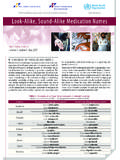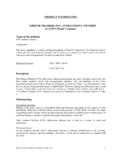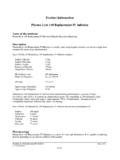Transcription of Data Sheet 3% Citanest DENTAL with Octapressin
1 3% Citanest DENTAL with Octapressin Data Sheet Dentsply Sirona (NZ) Ltd NEW ZEALAND DATA Sheet 1 PRODUCT NAME 3% Citanest DENTAL with Octapressin Injection 2 QUALITATIVE AND QUANTITATIVE COMPOSITION 3% Citanest DENTAL with Octapressin inj ection solution contains 30 mg/mL prilocaine hydrochloride and micrograms/mL felypressin. For the full list of excipients, see Section List of excipients. 3 PHARMACEUTICAL FORM 3% Citanest DENTAL with Octapressin is a sterile aqueous solution. The pH of the solution is 3% Citanest DENTAL with Octapressin inj ection solution in a standard and self-aspirating glass cartridge. The finished products is a clear and colourless solution packed in a carton containing 100 units of mL or mL Type 1 glass cartridges, closed on one end with a self-aspirating bromobutyl rubber plunger and at the other end by a bromobutyl disk covered by an aluminium cap.
2 The ampoules and cartridges are free from preservatives and are intended for single use only. 4 CLINICAL PARTICULARS Therapeutic indications Infiltration anaesthesia in dentistry, where there is no need for profound ischaemia in theinjected area. Regional nerve block anaesthesia in Dose and method of administration 3% Citanest DENTAL with Octapressin has a rapid onset of action after infiltration anaesthesia, with an average of 2-3 minutes. Inferior alveolar nerve block requires 5 minutes or more to take full effect. The duration of effective anaesthesia varies in individuals and depends on the type of block. The average duration of useful anaesthesia after infiltration is 45 minutes. After successful regional block, inferior alveolar nerve block, anaesthesia lasts for 2 hours or longer.
3 Injections should always be made slowly with careful aspiration before and intermittently during injection to avoid inadvertent intravascular injection, which may have toxic effects. The lowest dose that results in effective anaesthesia should be used. The dose will also depend on the area of the oral tissues to be anaesthetised, the vascularity of the oral tissues and the technique of anaesthesia. The total dose must be adjusted to the age, size and physical status of the patient. For effective local anaesthesia in most DENTAL procedures, an adequate dose of 3% Citanest DENTAL with Octapressin solution injected into the tissue is: In normally healthy adults: 1-5 mL (equivalent to 30-150 mg prilocaine hydrochloride). For routine DENTAL procedures, a dose of 10 mL (equivalent to 300 mg prilocaine hydrochloride) 3% Citanest DENTAL with Octapressin should not be exceeded.
4 3% Citanest DENTAL with Octapressin Data Sheet Dentsply Sirona (NZ) Ltd Children under 10 years of age: 1-2 mL (equivalent to 30-60 mg prilocaine hydrochloride). A rapid rate of injection may lead to complications due to the high concentration (see Section Overdose) even after the injection of small amounts. This is more likely following accidental intravascular injection. The injected medicine could be transported in a retrograde manner along a blood vessel and, in cases of intra-arterial injection in the head and neck area, reach the brain. Contraindications Known history of hypersensitivity to local anaesthetic agents of the amide type. Congenital or idiopathic Special warnings and precautions for use The safety and effectiveness of the local anaesthetic agent, prilocaine hydrochloride, depends on the proper dosage, the correct injection technique, adequate precautions and readiness for emergencies.
5 Although largely free of side-effects, as an additive to prilocaine , felypressin may cause a rise in blood pressure or coronary constriction if an overdose is given. Before administering a local anaesthetic medicine, make sure that resuscitative equipment, such as equipment required for oxygenation and assisted ventilation, and medicine for the treatment of toxic reactions are immediately available. The patient should be advised to exert caution to avoid inadvertent trauma to the lips, tongue, cheek mucosa or soft palate when these structures are anaesthetised. The ingestion of food should therefore be postponed until normal function and sensation returns. In the head and neck area, due to the proximity of the CNS, the intravascular injection of even small doses of local anaesthetics may cause systemic adverse reactions similar to those seen after the inadvertent intravascular injection of larger doses in other parts of the body.
6 Even if the dose of 3% Citanest DENTAL with Octapressin used in DENTAL practice is generally small, some patients may require special attention to reduce the risk of dangerous side effects: Patients with partial or complete heart block due to the fact that local anaestheticsmay depress myocardial conduction. Patients with advanced liver disease or severe renal dysfunction. The elderly and patients in poor general anaesthetics should be administered with caution to patients with severe or untreated hypertension, severe heart disease, severe anaemia or circulatory failure from whatever cause, or any other pathological condition. Local anaesthetics should be avoided when there is infection in the region of the proposed injection.
7 Regarding methaemoglobin formation see Section Undesirable effects. Interaction with other medicines and other forms of interaction prilocaine should be used with caution in patients receiving agents structurally related to local anaesthetics, since the toxic effects are additive. Medicines which may predispose to methaemoglobin formation, sulphonamides, antimalarials and certain nitric compounds, could potentiate this adverse effect of prilocaine . Due to its very low acute toxicity, felypressin does not increase the toxicity of a prilocaine solution. 3% Citanest DENTAL with Octapressin Data Sheet Dentsply Sirona (NZ) Ltd Fertility, pregnancy and lactation It is reasonable to assume that 3% Citanest DENTAL with Octapressin has been administered to a large number of pregnant women and women of child-bearing age.
8 No specific disturbances to the reproductive process have so far been reported, an increased incidence of malformations or other direct or indirect harmful effects on the foetus. Methaemoglobinaemia in the neonate has been reported after the administration of prilocaine to the mother in doses exceeding 600 mg. prilocaine may enter the mother s milk, but in such small amounts that there is generally no risk of this affecting the neonate. It is not known whether felypressin is excreted in breast milk. Effects on ability to drive and use machines Depending on dosage, local anaesthetics may have a very mild effect on mental function and may temporarily impair locomotion and co-ordination. Undesirable effects Reactions to 3% Citanest D ENTAL with Octapressin are very rare in the doses used in DENTAL procedures.
9 If adverse reactions occur, they are similar in character to those observed with other local anaesthetics. Allergic Reactions Allergic reactions (in the most severe instances anaphylactic shock) to local anaesthetics of the amide type are rare. Neurological Complications The incidence of adverse neurological reactions ( persistent neurological deficit) associated with the use of local anaesthetics is very low. Neurological reactions may be dependent upon the particular medicine used, the route of administration and the physical status of the patient. Many of these effects may be linked to the injection techniques, with or without a contribution by the medicine. Neurological reactions following regional nerve blocks have included persistent numbness, paraesthesia and other sensory disturbances.
10 Acute Systemic Toxicity prilocaine can cause acute toxic effects if high systemic levels occur due to accidental intravascular injection, fast absorption or overdosage. (See Section Pharmacodynamic properties and Section Overdose.) Methaemoglobinaemia Methaemoglobinaemia may occur after the administration of prilocaine . The repeated administration of prilocaine , even in relatively small doses, can lead to clinically overt methaemoglobinaemia (cyanosis). The conversion of haemoglobin to methaemoglobin is caused by the prilocaine metabolite, -toluidine, which has a long half-life and tends to accumulate, and in turn, by its conversion to 4- and 6-hydroxytoluidine. Methaemoglobin has risen to clinically significant levels in patients receiving high doses of prilocaine .

















